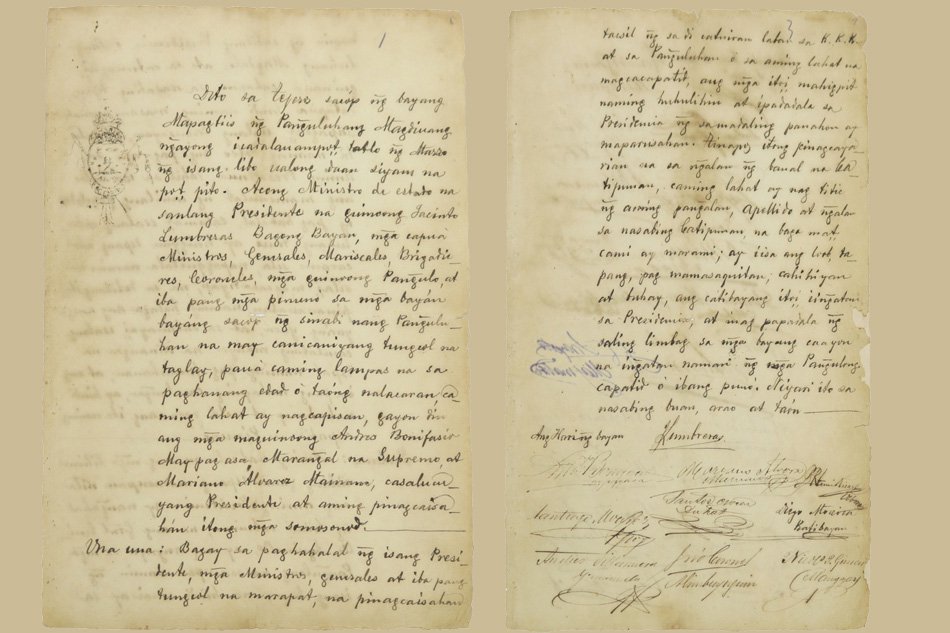The continuous struggle between the Filipino revolutionists and the Spanish forces since 1896 caused the two parties’ exhaustion by the end of 1897. The leaders of the Biak-na-bato Republic agreed to enter into a truce of peace. Although in essence, it was a surrender of the Filipino forces, they nonetheless negotiated with the implementation of reforms as well as 800,000 pesos as payment for war damages. Out of this amount, 400,000 was placed under the name of Emilio Aguinaldo to be given after they left the Philippines. It was given to him afterwards and deposited to a bank in Hong Kong. This scenario prompted some of Aguinaldo’s critic to blame him of “selling the cause of the revolution” and taking the 400,000 pesos for himself.
| Notable Historical Events | Mabini’s Alliance/Loyalty to Bonifacio? | Mabini’s Alliance/Loyalty to Aguinaldo? | OTHER OPINIONS |
| Meeting of Quezon and Aguinaldo after Philippine-American War (1901, verify please) | “As I entered the room, I saw General Aguinaldo – the man whom I had considered as the personification of my beloved country, the man whom I had seen at the height of the glory surrounded by generals and soldiers, statesmen and politicians, the rich and the poor, a prisoner of war…. I felt that the whole world had crumbled and that all my hopes and all my dreams for my country were gone forever!” Mr. Chairman, I wish to say a few words in behalf of General Aguinaldo. I was at one time an officer in the Philippine Army…For several months I was on the staff of General Aguinaldo, then President of the Philippine Republic and commanding general of the army…. I can assert without fear of successful contradiction that he is a man of high character and patriotism…. During the Philippine Revolution against Spain, Aguinaldo was the supreme military chief, with the powers of a dictator…He had the physical power to do with the treasury of the then-independent Philippine government as he pleased. When he was captured by General Funston after having exercised his undisputed authority for more than two years, Aguinaldo was as poor as when the Philippine-American War started. How many revolutionary chiefs in other parts of the world who have been in the position of General Aguinaldo have done what he did? How many have been willing to go back to their homes as poor as ever after having had in their possession so much money that they could have appropriated without question? Aguinaldo is not a rich man today. He is a modest farmer. He has not accepted any position from the American government…Why? He wanted to show the world that he fought for his country not because of any desire for personal profit or power but out of patriotism, and that when he could not fight any longer he could go to his home and lead a peaceful and modest life, the life of a good citizen working on his farm… Thus Aguinaldo has demonstrated that the Filipinos, who [have] known how to fight for their freedom, know likewise how to work in time of peace. I need not say more." | The relationship between Quezon and Aguinaldo was still cordial. | |
| Quezon in Politics (1920, verify date) | Aguinaldo not in politics at all. He was attending to veteran’s affairs and farming. | MLQ was resident commissioner in Washington DC. Quezon took advantage of his closeness with the Americans, resurrected Mabini memoirs which had been lying dormant the past thirty years and which were very anti-Aguinaldo. Quezon in the meeting with Aguinaldo (as witnessed by Larry Henares) denied that he (Quezon) used these negative materiale against Aguinaldo. Quezon blamed the Americans for the adverse publicity. (Refer to letter of Henares) Aguinaldo naively said “In a democracy, you need opposition.” Aguinaldo and Quezon were good friends, with Quezon acknowledging that he was a loyal follower of Aguinaldo as lieutenant sergeant. He praised Aguinaldo in the US congress. Aguinaldo did not enrich himself and that his financial situation did not change before and after the revolution (according to Quezon). To retaliate against Aguinaldo for running against him during the election, Quezon removed Aguinaldo’s pension 12,000 pesos a year. Quezon also foreclosed the 1000 hectares of Aguinaldo property in Paliparan, Dasmarinas, Cavite which were sold by the Americans to Aguinaldo among others as part of the Agrarian Reform. Quezon did not foreclose on any other owner. - PM Virata |
|
| Quezon’s Discontentment with Aguinaldo (1920’s, double check) | Harrison, wanted Filipinization of the Philippine government except treasurer of the Philippines who must be American. Before this could be implemented, Harrison was replaced by Leonard Wood. Leonard Wood meddled in a case of a Manila Police officer who was American (ISSUE TO BE VERIFIED). Filipinos in the government resigned because of meddling of Leonard Wood. Aguinaldo sided with Leonard Wood. Quezon resented the support of Aguinaldo. | ||
| Aguinaldo decides to run against Quezon (1934) | Quezon teamed up with the Americans to destroy Aguinaldo. Resurrected the Mabini memoirs. Resurrected Bonifacio – Luna “assassinations” According to Alfredo Saulo re: Quezon’s complication with the accusations made against Gen. Aguinaldo: For instance, there is no way to prove that Quezon was behind it, but it is a fact that his followers revived the rumors that Aguinaldo had ordered both the execution of Andres Bonifacio, and the assassination of General Antonio Luna. It is difficult to put the blame on Quezon because sometimes sycophants would take the initiative of besmirching the reputation of Aguinaldo in hopes of currying favor from the man (Quezon) who buttered their bread with political patronage. General Pantaleon Garcia was captured by the Americans in Jaen, Nueva Ecija, in May 1900, but was subsequently released. He then served as municipal president of Imus in 1903-1905 and justice of the peace in 1906-1907. Later he was appointed superintendent of the Colonia Agricola (Farm Colony), in Cavite. In 1933 General Garcia issued a startling statement to the effect that before the death of General Luna on June 5, 1899, he (Garcia) had received a verbal order from General Emilio Aguinaldo that I (should) lead the projected assassination of General Luna, which would be done at Cabanatuan, Nueva Ecija. It so happened that I was unable to perform that order. After some days had passed I received the news that General Luna was murdered at Cabanatuan by the soldiers from Kawit. Intensive research, however, has disclosed that when Garcia made the statement in 1933, he was serving as sergeant-at-arms of the Philippine Senate, of which Quezon was the President, and that the Aguinaldo-Quezon political controversy was at its height with the Commonwealth presidential election barely two years away, well within the time frame of the polls. Evidently, the Garcia statement had political undertones tending to besmirch the image of General Aguinaldo. Quezon having been a man of great foresight, it is quite possible that even then he spared no effort in trying to eliminate a potential rival for the Presidency of the Philippine Commonwealth. Quezon was at the height of his political power before the Commonwealth election, and no man in the opposition except Aguinaldo would have dared run against him. So Aguinaldo had to be trimmed by all means. This seamy side of American politics Quezon learned in his six-year stint at the American capital to insure his own political future. The same political motivation was behind the reported “funeral reception” accorded Aguinaldo and his followers when they arrived in Malolos, Bulacan, on January 23, 1928, to commemorate the twenty-ninth anniversary of the inauguration of the First Philippine Republic. “Nearly all the houses and stores of the town closed their doors and windows and displayed black flags,” says a long-time Aguinaldo detractor; “the church bell rang out the lugubrious plegaria; all business activities were suspended; and placards were posted in different parts of the town with the provocative question, Emilio Aguinaldo…who shall answer for the death of the two Filipino patriots, Luna and Bonifacio? It is well to remember that the continuing accusation against Aguinaldo for the deaths of Bonifacio and Luna stemmed from Apolinario Mabini’s scurrilous and malicious allegations in his book La Revolucion Filipina, written with evident rancor during his exile in Guam. That Mabini, a former assistant attorney in the office of the patriot Numeriano Adriano and so-called “Brains of the Revolution,” used hearsay evidence to assassinate the character of Aguinaldo, Mabini’s former benefactor, is not only the height of ingratitude but also a disgrace to the legal profession. Another and more subtle way to downgrade Aguinaldo was to extoll Bonifacio to the skies despite the lack of historical justification for it. It was a Quezon-dominated Philippine Legislature that passed Act no. 2946 on February 16, 1921, making Bonifacio’s birthday anniversary, November 30, the legal holiday that it still is. It was also the same legislature that appropriated the funds which, together with an amount raised through popular subscription, were used to erect the gigantic Bonifacio monument at the Balintawak rotunda in Caloocan City. PNP Camp in Imus is named after General Pantaleon Garcia. | GEA made a huge mistake in entering the dirty world of Philippine Politics. Worse he went up against a very popular, good-looking mestizo, Manuel Quezon Sr. GEA did not realize that the Americans who were still angry at him for the Philippine American War would utilize their propaganda machinery to destroy GEA and in the process helped MLQ . The Americans used MLQ to help run the Philippines under the US-Commonwealth Government. - GGS |
|
| Election Proper (President of the Commonwealth, 1936) | Quezon knocked out Osmena and Roxas faction. Thereby enabling Quezon to become Senate President. Quezon climbing the political ladder. | ||
| Presidency | After Quezon became president, he removed 12,000 pesos pension per year of Aguinaldo and foreclosed Paliparan property (1000 hectares, Dr. Diaz to confirm source) of Aguinaldo allegedly of delayed payments. In contrast, Quezon did not foreclose on other properties in other places. | Aguinaldo donated PNP property in Silang, Cavite (PNPA), at least 200 hectares. (sources) | |
| Japanese Occupation (1941-1945) | Quezon was in the US very sick – government in exile. It was the US military directing all Philippine operations (verify source). Pentagon planning was to establish main base in Taiwan but Gen. McArthur prevailed to honor his commitment to return to the Philippines. No matter what the cost and no matter the destruction would be. Quezon died in 1944. | Aguinaldo was in the Philippines and wrote a letter to McArthur in April 1942 to convince McArthur to surrender the Philippines to avoid further bloodshed and destruction. Aguinaldo even had a radio broadcast to convince the Filipinos to surrender and the American Forces in the Philippines to surrender. Bataan fell in April 9, 1942, Corregidor fell in May 7, 1942. |
We encourage healthy exchange of ideas on this website. Share your thoughts via info@heroesall.ph We welcome opinions that can widen the understanding of our history. Information and/or opinions will be posted on the third column as deemed vital by our editors.

